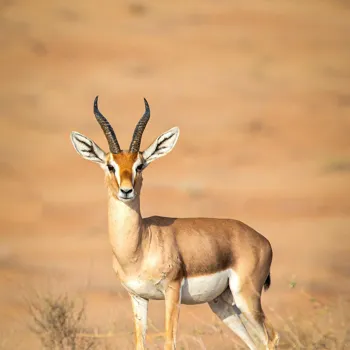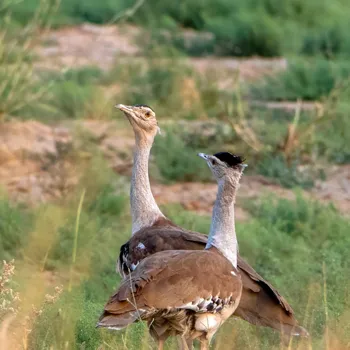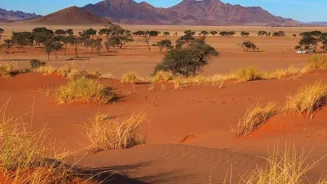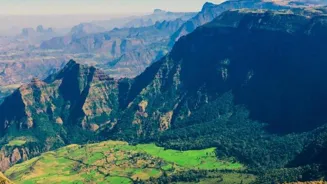Discover the incredible animal adaptations in India's Thar Desert, a testament to nature's resilience and evolution. Read more to explore the secrets of survival in this harsh landscape
The Thar Desert,
also known as the Great Indian Desert, is a harsh and unforgiving landscape. Stretching across a large part of Rajasthan and extending into neighboring states, this arid region presents immense challenges for survival.
Yet, a surprising variety of animals call the Thar home, each possessing remarkable adaptations that allow them to thrive in this extreme environment. These adaptations are a testament to the power of evolution and the resilience of life.
Animals in India's Thar Desert adapt to survive harsh conditions
India's Thar Desert is a hot and dry place with very little water. The animals that live there have developed some amazing ways to survive. They have learned how to deal with the heat, find water, and protect themselves from predators.
These adaptations are often subtle, but they are essential for these animals to make a living in such a difficult environment. Observing them gives us an insight into nature's clever ways.
Camels are uniquely adapted to thrive in the desert environment
One of the most iconic animals of the Thar is the camel, often called the "ship of the desert." Camels are supremely adapted to desert life. They can survive for long periods without water, thanks to their ability to store water in their bloodstream and tolerate dehydration.

Their humps store fat, which can be converted into energy and water when needed. Camels also have thick eyelashes and bushy eyebrows to protect their eyes from sand and sun, and their wide, padded feet prevent them from sinking into the sand.
Their nostrils can be closed to keep sand out during sandstorms. These features contribute specifically to their endurance.
Indian gazelle Chinkara's survival tactics in the desert
The Indian gazelle or Chinkara is another amazing animal. This graceful Chinkara is well-equipped for desert survival. They are mainly active during the cooler hours of dawn and dusk to avoid the intense heat of the day.

Their pale coat provides effective camouflage, helping them blend into the arid landscape and evade predators. Chinkaras can obtain water from the plants they eat, reducing their dependence on scarce water sources.
They are also very agile and can run at high speeds, allowing them to escape danger quickly. Overall, they survive by staying hidden and using as little energy as possible.
Desert fox survives Thar's harsh conditions with cunning, camouflaged hunting
The desert fox, or Bengal fox, is a cunning predator that has adapted to the harsh conditions of the Thar. It has large ears, which help dissipate heat and also provide excellent hearing to detect prey. The desert fox is nocturnal, which helps it avoid the scorching daytime temperatures.

Its sandy-colored fur provides camouflage, allowing it to sneak up on prey like rodents, birds, and insects. It is a resourceful animal that can survive on a varied diet, making it well-suited to the unpredictable food availability in the desert.
Their nocturnal habits and efficient hunting abilities ensure survival.
Desert reptiles adapt to harsh environment for survival
Reptiles like various species of lizards and snakes are abundant in the Thar Desert. These animals are cold-blooded, which means they can regulate their body temperature by basking in the sun or seeking shade. Many desert reptiles have thick scales that help prevent water loss.
Some lizards can even absorb moisture from the sand through their skin. They often bury themselves in the sand to escape the heat and avoid predators. Snakes also play a vital role in the desert ecosystem, controlling rodent populations. They find shade under rocks.
Great Indian Bustard is critically endangered due to unique adaptations
Birds such as the Great Indian Bustard are uniquely adapted. Sadly, however, this magnificent bird is critically endangered. It has long legs that help it walk through the desert terrain and a long neck that allows it to spot predators from a distance.

The Great Indian Bustard is primarily a ground-dwelling bird. It feeds on insects, grasses, and small reptiles. Its mottled plumage provides excellent camouflage in the arid landscape. Conservation efforts are crucial to protect this iconic species and its fragile habitat.
Studying Thar Desert animals reveals ecology and evolution insights
Studying the adaptations of animals in the Thar Desert provides valuable insights into the principles of ecology and evolution. It is interesting to observe the ways in which different species have converged on similar solutions.

We can gain a deeper appreciation for the importance of biodiversity and the need to protect these unique ecosystems. The Thar Desert is a living laboratory. This lab showcases the ability of life to adapt and persist even in the face of extreme adversity.











